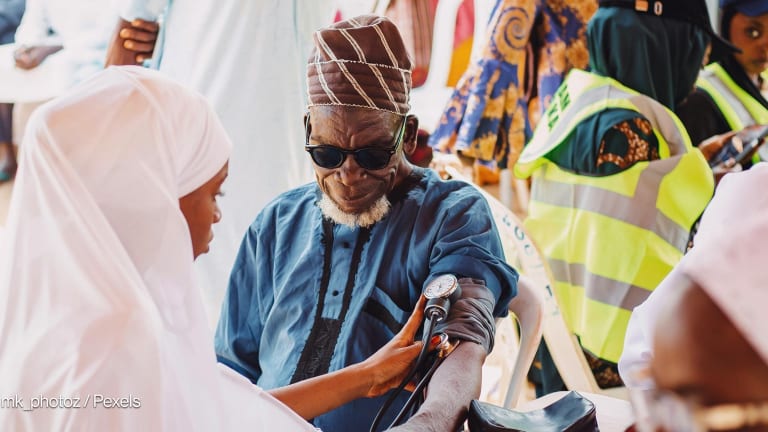It’s estimated that an extra $2.5 trillion of funding will be needed each year in order to achieve the 2030 Sustainable Development Agenda. So just where is that money going to come from?
On July 12, as a part of Going for Goals content series, Devex hosted a Twitter chat where major global development and private sector organizations discussed the innovative financing models needed to achieve the Sustainable Development Goals by 2030 and the mechanisms that will have the most impact on people's lives.
See more topics:
► Opinion: Getting climate infrastructure right — A stronger role for development banks
► India turns to the private sector to bring health care to underserved areas
► Innovative financing for health: Insights from the Grand Challenges Award Repository
These and many other experts took part in the conversation:
• Omar Campos, Senior Director of Funding Partnerships, Philips
• Angela Marcarino, Head of Asia and Pacific, European Investment Bank
• Albena Melin, Head of Global Engagements, Blended Finance & Partnerships, International Finance Corporation
• Roberto Ridolfi, Director, Planet & Prosperity, EuropeAid
Read the highlights below.
• @PhilipsHealth We’re seeing different stakeholders; from bilateral & multilateral org, country wide & regional governments, NGOs to venture capitals, institutional investors, seed capital companies, private sector vendors. These stakeholders should hone local entrepreneurs to make a business out of these projects to ensure sustainability
• @RobRidolfi Financing gap can only be filled if private investors step in. Development agencies and governments must work in partnership
• @AngelaMarcarino Public and private sectors necessary, not sufficient. Financial markets and institutional investors also not enough
• @IFC_org Without private sector expertise & investment the ambitious SDG agenda will not be reached. If biz put their strategies towards achieving the SDGs, we’ll be opening up an add'l $12 trillion in market opportunity
• @USAIDGH Key stakeholders include traditional funders, but more importantly, country governments are crucial for sustainable response
• @MSHMarian Besides the usual funders, local communities must play a key role in creating innovative solutions & contributing $
▶ See all the great answers for question one here.
• @PhilipsHealth Governments are partnering with private sector via innovative mechanisms as PPPs & Managed Equipment Services (MES)
• @BetterThan_Cash Our new study discusses how epay methods could unlock $50B/year required to achieve #energy access 4all http://ow.ly/33OM30dvDNq
• @RobRidolfi Blending public-public and public-private! The trend is to leverage from billions to trillions. #EEIP aims to do that
• @Rotary Matching grants have allowed organizations to pool their finances and increase impact
• @MSHHealthImpact On a local level, govt’s & others are funding performance based financing; it shows good results
▶ See all the great answers for question two here.
• @PhilipsHealth In PPPs, private sector’s management, innovation & efficiency can be used to improve government service delivery
• @IFC_org Investors look at risk return considerations. There has to be financial return – profit but also development impact. At IFC we strongly believe & demonstrate there is no trade off between both, purpose & profit go hand in hand.
• @RobRidolfi Potential for investment in Africa is the greatest. To unleash it we need to reduce risk and the perception of it
• @ConvergenceBF For most impact, investment needs to be directed to low-income countries, with Africa being a top priority region
• @GHLeaders Invest in countries with high #NCD rates such as India, South Africa, & Brazil
▶ See all the great answers for question three here.
• @PhilipsHealth Strengthening primary care is the most effective way to improve & pave the way for Universal Health Coverage. Primary care needs to be based on community needs to include healthy living & prevention
• @RobRidolfi Partnership will go beyond traditional players - we need to include everyone from CSOs to the private sector
• @IFC_org Inclusive development is about ACCESS. Giving access to poor people to markets, goods, jobs, services. It is about creating markets that serve & benefit ALL in a given society.
• @plus_socialgood Investors must use resources to find diverse applicants & programs. It's not as simple, but the results will be better
• @JohnHewko Models that support local action benefit from partnerships inside of the community
▶ See all the great answers for question four here.
• @PhilipsHealth Combining government income with private income flows to facilitate new self-sustainable models
• @RobRidolfi Innovative products and activities under the #EEIP can include social impact investments, such as support to MSMEs that invest in health activities such as lab services, delivery mechanisms or local production of simple medical devices
• @EndPolioNow Funding global health projects at the local level helps spread awareness & urgency
• @WomenThrive Better engagement w/ grassroots orgs. They r the real development experts! W/ more $, they'll make long-lasting change
• @OECDdev Encourage local capital participation & #FX #RiskSharing instruments in #BlendedFinance http://bit.ly/2jTZLW2
▶ See all the great answers for question five here.
• @PhilipsHealth Hybrid financing with appropriate risk mitigations by bi & multilateral agencies are key to spice appetite of private sector
• @AngelaMarcarino Development partners absorbing risks, providing guarantees for intermediaries, who on-lend to specific beneficiaries
• @EcoAgPartners Among best ways to mitigate risk is investing in long-term adaptive collab. mgmt at landscape level
• @RobRidolfi Multilaterals bring innovative financing to create a risk profile so private companies can come in and invest
• @EndPolioNow Broad assumptions can lead to leaving many behind. Speak to local leaders & learn about communities' needs before investing
▶ See all the great answers for question six here.
• @PhilipsHealth Elevating awareness of these common goals & supporting the stakeholders and finally create the sense of urgency to achieve results
• @IFC_org Hope for HLPF on the #SDGs to deepen partnerships between private sector, civil society, public sectors, foundations.
• @AllaKos_Dev Strong focus on reviewing real progress made under #SDG17 + practical approach & commitmets 4 #collaboration #partnerships
• @WomenThrive At #HLPF2017 - awareness abt the fact that grassroots orgs are #StillLeftBehind & aren't #InTheRoom for SDG decision-making
• @OneYoungWorld We hope #HLPF2017 will focus on the power of #youngleaders in advancing the #GlobalGoals
• @GHLeaders hopes to see continued conversation around partnership for the goals #SDG17 #PPPs #HLPF17
▶ See all the great answers for question seven here.
Over 10 weeks Devex, along with our partners the European Investment Bank, the International Finance Corporation, Philips, and the United Nations Development Programme, will take an in-depth look at the innovative financing mechanisms driving forward the 2030 sustainable development agenda. We’ll explore how the funding gap can be filled, ask how cross-sector collaboration can lead to improved global health care, and look at what it takes to build successful partnerships for change. Join us as we examine the innovative financing powering the Global Goals by tagging #Going4Goals and @devex.








